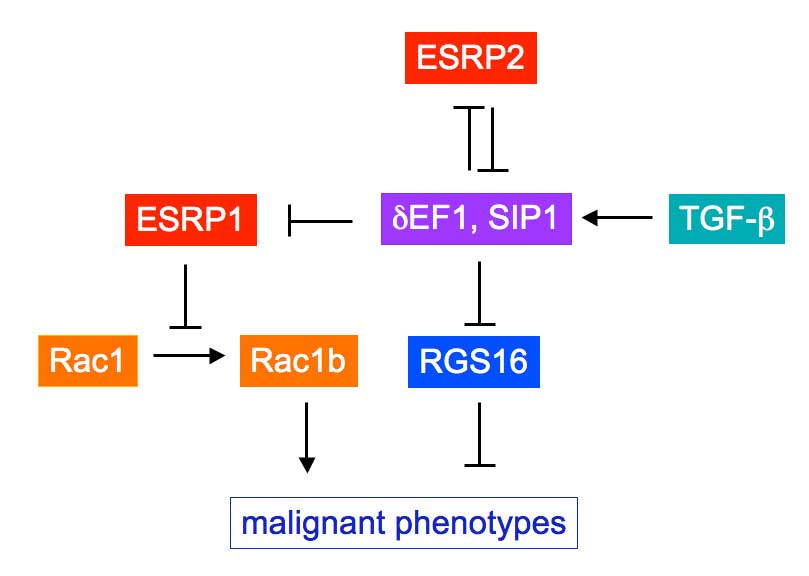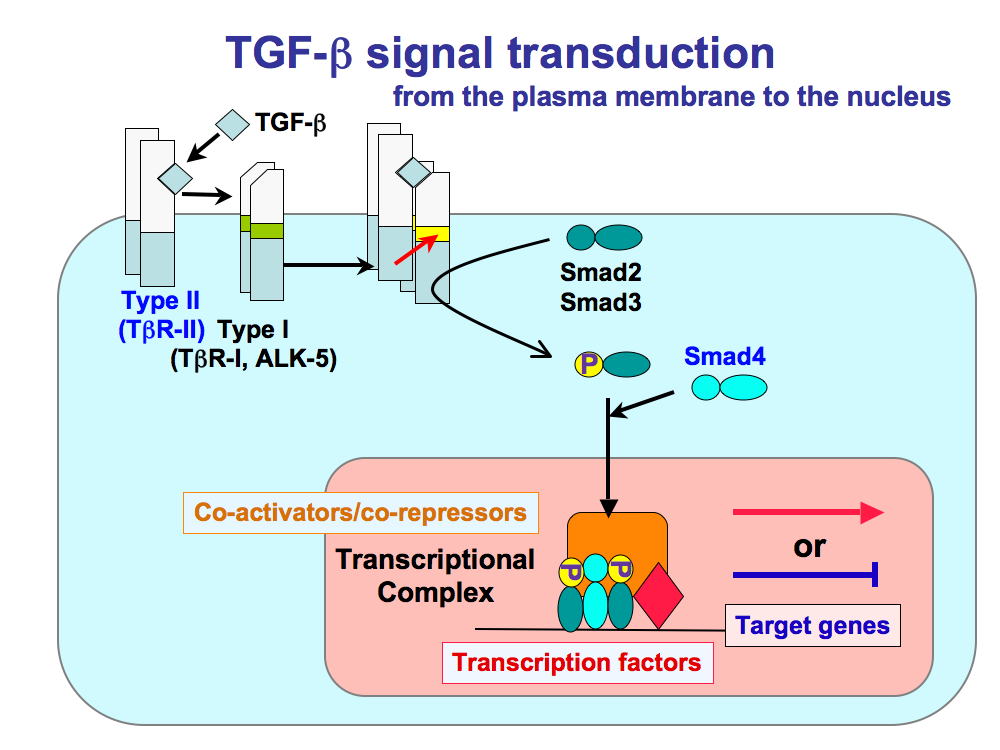|
|
|
Department of Biochemistry
|
|
Research Projects
|
|
°°Our research covers signal transduction and molecular mechanisms of tumor progression.
Especially we focus on the roles of transforming growth factor-¶¬ (TGF-¶¬) and transcription
factors that induce malignant phenotypes of cancer cells, i.e. ¶ńEF1 (ZEB1) and SIP1 (ZEB2).
|
|
1.TGF-¶¬ signaling and tumor progression
|
|
°°TGF-¶¬ is a growth factor that is widely distributed in our body, and most cells are thought to express signaling receptors for TGF-¶¬.
Intriguingly, TGF-¶¬ evokes distinct cellular responses in different types of target cell,
which may be beneficial or detrimental depending on the contexts of its action. For example,
TGF-¶¬ is a tumor suppressor in normal cells, while it facilitates malignant phenotypes in transformed cells.
We try to elucidate the molecular basis underlying the context-dependent TGF-¶¬ signaling.
Our research will lead to development of strategies to regulate TGF-¶¬ signaling in a cell-response-selective manner.
|
|
|
|
°„Selected Publications> |
|
| Saitoh M, Endo K, Furuya S, Minami M, Fukasawa A, Imamura T, Miyazawa K STAT3 integrates cooperative Ras and TGF-¶¬ signals that induce Snail expression. Oncogene. 2016 Feb 25;35(8):1049-57 |
|
| Motizuki M, Isogaya K, Miyake K, Ikushima H, Kubota T, Miyazono K, Saitoh M, Miyazawa K. Oligodendrocyte transcription factor 1 (Olig1) is a Smad cofactor involved in cell motility induced by transforming growth factor-¶¬. J Biol Chem. 288:18911-18922 (2013) |
|
| Ikushima H, Komuro A, Isogaya K, Shinozaki M, Hellman U, Miyazawa K, Miyazono K. An Id-like molecule, HHM, is a synexpression group-restricted regulator of TGF-¶¬ signalling. EMBO J. 27:2955-2965 (2008) |
|
|
2. Regulators of malignant phenotypes of cancer cells
|
|
°°Malignant phenotypes of cancer cells are regulated by a plethora of factors.
Among those, we focus on transcription factors, ¶ńEF1 (ZEB1) and SIP1 (ZEB2),
as well as RNA splicing factors ESRP1/2 (epithelial splicing regulatory proteins).
We recently found that these factors form a complex network to regulate malignant phenotypes of cancer cells,
through mutually affecting expression and functions.
We aim to find strategies to suppress tumor progression by manipulating this complex network.
|
 |
|
°„Selected Publications> |
| Ishii H, Saitoh M, Sakamoto K, Kondo T, Katoh R, Tanaka S, Motizuki M, Masuyama K, Miyazawa K. Epithelial Splicing Regulatory Proteins 1 (ESRP1) and 2 (ESRP2) Suppress Cancer Cell Motility via Different Mechanisms. J Biol Chem. 2014 Oct 3;289(40):27386-99. |
| Horiguchi K, Sakamoto K, Koinuma D, Semba K, Inoue A, Inoue S, Fujii H, Yamaguchi A, Miyazawa K, Miyazono K, Saitoh M. TGF-¶¬ drives epithelial-mesenchymal transition through ¶ńEF1-mediated downregulation of ESRP. Oncogene. 2012 Jun 28;31(26):3190-201. |
| Shirakihara T, Horiguchi K, Miyazawa K, Ehata S, Shibata T, Morita I, Miyazono K, Saitoh M. TGF-beta regulates FGF receptor isoform switching and epithelial-mesenchymal transition. EMBO J. 2011 Feb 16;30(4):783-95. |
| Members | |
| Keiji Miyazawa | Professor |
| Masao Saitoh | Professor°°(Center for Medical Education and Sciences) |
| Shigeo Otake | Research Associate |
| Yuka Itoh | Research Associate |
| Takashi Yokoyama | Research Associate |
| Arisa Kinouchi | PhD student (Otolaryngology) |
| Fu Hao | PhD student (Medicine) |
| Asuka Obikane | MSc Student |
| Kaori Endo | Technical Staff |
| Chiho Omata | Technical Staff |
|
Link to
Publications list
Department of Biochemistry,Faculty of Medicine, Universtiy of Yamanashi, 1110 Shimokato, Chuo, Yamanashi, 409-3898 JAPAN °° 

|

